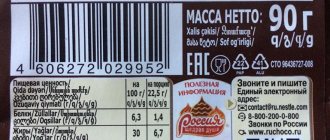During customs clearance, much attention is paid to the EAC marking of goods (pronounced “EAK” in professional slang). Due to the lack of such markings, the goods may be confiscated or sent back to the foreign supplier. From our article you will learn who, where and how should label a product, and how to avoid problems due to incorrect labeling.
Article about types of markings
What is EAC?
EAC is a sign of product circulation on the market of the Customs Union.
EAC marking is applied to goods that are subject to mandatory certification or declaration of conformity in accordance with the requirements of technical regulations of the Customs Union (EurAsEC). EAC stands for Eurasian Conformity (from the English “Eurasian Conformity”)
The EAC logo applied to the product informs the consumer that a certificate or declaration of conformity has been issued for the product.
Read the regulations on the unified mark of product circulation on the market of the member states of the Customs Union
Labeling of products with the EAC mark
20.05.2021
Labeling of products with the EAC mark
One of the basic provisions of technical regulation in the Eurasian Economic Union (EAEU) is to ensure the safety of products released into circulation on the territory of the Union.
In this regard, in accordance with the current legislation, products that are subject to confirmation of compliance with the requirements of technical regulations applied in the territory of the EAEU, and have passed all assessment procedures established by technical regulations, must be marked with a single circulation mark “EAS”. Moreover, the marking with a single circulation mark is applied to the product itself and the documents attached to it before the product is released into circulation on the EAEU market. It is important to emphasize that it is not permitted to label products with the EAC mark if their compliance with the requirements of technical regulations has not been confirmed. Responsibility for this action for legal entities in accordance with Article 14.46 of the Code of the Russian Federation on Administrative Offenses (CAO RF) provides for the imposition of a fine from 100 to 300 thousand rubles, and in the event that, as a result of the above actions, in particular, harm to life is caused or the health of citizens, or property, then the fine for legal entities can range from 700 thousand to 1 million rubles. It is obvious that the requirements of the above regulatory requirements should apply not only to products manufactured in the territory of the EAEU, but also to imported products imported for the purpose of distribution on the territory of the Union. At the same time, one cannot fail to note the nuances of the practice of bringing to administrative responsibility participants in foreign trade activities for the absence of the EAC mark on imported products imported for commercial purposes.
Until some time, customs authorities actively initiated cases of administrative offenses under Part 3 of Article 16.2 of the Code of Administrative Offenses of the Russian Federation when goods were identified during customs control without being marked with a single sign of circulation, qualifying this violation as the provision of invalid documents for products. But in 2018, the Federal Customs Service of Russia published letter N 01-11/50898 dated August 15, 2018, an explanation according to which the absence of only marking with the EAC sign on goods transported across the customs border of the EAEU included in the List of products in respect of which the filing of a customs declaration is accompanied by the submission document on assessment of conformity with the requirements of technical regulations of the EAEU, does not entail the invalidation of documents on assessment of conformity of products presented during customs declaration in order to confirm the fact of compliance with established prohibitions and restrictions, and accordingly does not constitute an administrative offense, liability for which is provided for in Part 3 of Article 16.2 , Articles 16.7, 16.17 of the Code of Administrative Offenses of the Russian Federation.
At the same time, in 2021, the Supreme Court of the Russian Federation, by its resolution, explained that failure to comply with the requirement to label products with a single sign of circulation is the basis for bringing to administrative liability provided for in accordance with Article 16.3 of the Code of Administrative Offenses of the Russian Federation: non-compliance with prohibitions and (or) restrictions for the import of goods into the customs territory of the Eurasian Economic Union or into the Russian Federation.
It should be noted that at present, the law enforcement practice of the customs authorities of the Russian Federation is not distinguished by a uniform approach to the legal assessment of the identified facts of the absence of marking with the EAC mark on products that have passed confirmation of compliance with the EAEU TR: in some cases, a participant in foreign trade activities may be faced with a refusal to release the declared goods, and somewhere customs authorities initiate cases of administrative offenses under the specified circumstances.
When considering the issue of labeling products with a single product circulation mark, one cannot fail to mention exceptions to the general rule. In the absence of the EAC marking on imported products, the Law provides for 2 options for applying a single circulation mark on the territory of the Russian Federation:
- in customs warehouses of the Russian Federation after placing goods under the appropriate customs procedure;
- in any other place after placing the goods under the customs procedure of conditional release for domestic consumption.
Do you have any questions about product labeling with the EAC mark?
Ask your question by phone or write to us by email
What if we label all the products in a row?
Many importers ask that everything possible be labeled, just to be on the safe side. But this is incorrect and can lead to problems at customs. If a foreign sender places a single circulation mark on products that are not subject to mandatory marking with this logo, then this product can also be sent for re-export at the discretion of customs. All associated costs will be borne by the recipient of the cargo, and this is a rather expensive “pleasure”. So we will have to take this issue seriously.
Where is the marking applied?
Each unit of piece goods, packaging, and accompanying documents is subject to marking. The image is monochromatic, in contrast to the color of the applied surface. Where to apply the marking depends on the type of product. For each product, a place is defined in the technical regulations. This can be transport or retail packaging, a label, the product itself, or sheets of inserts in product containers. Therefore, in each specific case of import, you need to study the relevant regulations - all the rules are spelled out in it.
Labeling should not mislead the consumer. If the product has passed voluntary certification of quality and safety, then this mark should not coincide with the EAC, overlap it or impair visibility or readability.
The sign cannot be smaller than 5 mm. The final dimensions are set by the manufacturer, importer or recipient. Basic requirements for labeling:
- Clarity and clarity of the image, its durability;
- All letters must have right angles, be the same height and width;
- The abbreviation forms a perfect square.
The legislator does not impose special requirements on the method of applying EAC. This can be a handmade icon or using a hardware and software system. The main thing is documentary evidence of completion of all procedures established by regulations to confirm quality and safety.
How long will the EAC mark be valid?
The Customs Union is getting stronger and expanding every year, so the relevance of the EAC marking will certainly remain for a very long time. With the increase in trade turnover in the single economic space, control over compliance with the measures in force on its territory will become stricter.
Foreign suppliers of imported goods do not fully understand the seriousness of this issue, and the task of every importer in the territory of the Customs Union is to convey to them a list of all possible consequences that will negatively affect their business.
What should it be applied to?
According to current legislation, it must be present at facilities of the following groups:
- children's and teenagers' things, including toys;
- pyrotechnics;
- Perfumes and cosmetics;
- nutrition (including dietary, preventive and therapeutic) and/or juices made from vegetables and/or fruits;
- equipment (low voltage);
- animal and vegetable oils and fats, as well as their derivatives;
- furniture;
- tobacco products;
- individual protection means.
This is an incomplete list - the list can be continued, which is what the compilers of norms and standards do. Therefore, it is better for foreign trade participants to separately inquire whether this identifier needs to be applied to a particular object of sale or purchase. This approach may seem too thorough, but in the end it will be completely worth it, because it will help you avoid fines and generally problems with the Federal Customs Service and will save time and nerves.
What if the products have different markings?
If your products are marked with other marks, for example, a mark of conformity with voluntary certification, then they should not interfere with the ease of identification of the EAC mark. This means that the technical regulations of the Customs Union do not allow the application of other inscriptions, design elements or images on the product or its packaging that could make it possible for the consumer to misinterpret the EAC mark. Simply put, the EAC mark must be clearly visible against the background of other marks on the product.
Violations of labeling rules
During inspections carried out by customs authorities, the most common violations of labeling rules are:
- absence of mandatory EAC markings on cargo;
- the marking is pasted on the package, but is not on the product itself;
- the EAC mark on the label does not look correct (the letters are blurred, the font is of different sizes, the marking is applied unevenly). This gives reason to believe that the marking is illegal.
At the stage of agreeing on the contract, it is necessary to secure with the seller a set of necessary information that must be indicated in the labeling on each unit of goods and on each piece of cargo (in accordance with the requirements of the technical regulations for this product). But often the seller is careless about the order in which information is indicated on the label. Therefore, a foreign trade participant receives goods with incomplete or unreliable information on the labels: the manufacturer is not indicated, the country of origin is not indicated, the storage temperature or expiration date is indicated incorrectly, etc.
There are cases when, in order to save money, the seller packs the goods in containers that indicate information remaining from the previous batch. Thus, it turns out that the requirements for one product are indicated on the packaging, but another is located inside.
How to avoid labeling mistakes?
1) Consult a broker.
Find out in advance from your customs broker which customs codes of the Tax Code for Foreign Economic Activity for your planned load are subject to mandatory certification according to the technical regulations of the Customs Union.
2) Check the codes at the certification center.
For greater confidence, we recommend contacting a certification center and once again checking the customs codes received from the broker for the need for certification.
If you order all services to support an import transaction from one company using the “one window” system (for example, through Iraid.ru
), then you will immediately receive an accurate answer, which will be agreed upon not only by a customs specialist, but also by an expert on permitting documentation. It is very convenient and reliable.
3) Create clear instructions for the foreign supplier
. If the list of products you import is limited, then over time you will be able to create clear instructions for the foreign supplier, which he will use to label goods before shipment.
Which products must be marked with the EAC mark?
To date, more than 40 technical regulations have been developed and approved, and with the advent of new products, their number continues to increase. Products subject to labeling are listed in these documents:
- TR TS 001/2011: locomotives, passenger and freight cars, multiple unit and special railway rolling stock;
- TR TS 002/2011: high-speed railway transport, namely high-speed railway rolling stock, its components, infrastructure (automation and telemechanics, telecommunications, structures and devices;
- TR TS 003/2011: railway transport infrastructure, including railway subsystems (automation and remote control, telecommunications, structures and devices);
- TR CU 004/2011: household appliances for cooking, washing, ironing, cleaning rooms, air conditioning systems, heating appliances, vibration massagers, fitness equipment, sewing and knitting machines, chargers, power supplies, electrical voltage stabilizers, garden equipment, aqua systems, lamps , extension cords, PCs, musical power instruments, switches, cables;
- TR CU 005/2011: packaging and closures made of various materials: metal (barrels, flasks, kegs, canisters, tubes, cylinders, drums), polymers (films, boxes, bottles, bottles, bags, bags, containers), paper, cardboard, glassine (boxes, packs, trays), glass (jars, ampoules), as well as wood, textiles, ceramics;
- TR CU 006/2011: pyrotechnics, including anti-hail flares, pyrotechnic charges, igniters, pyrobolts, cutters, signaling means;
- TR CU 007/2011: products for children and adolescents, including pacifiers, sanitary and haberdashery products, disposable hygiene products, dishes and cutlery, toothbrushes and massagers, clothing, knitwear, shoes, leather goods, bicycles, magazines and books, writing and school supplies,
- TR CU 008/2011: toys, swimming pools for children, paints, holiday accessories;
- TR CU 009/2011: perfumery and cosmetic products, including essential oils, perfumes, eau de toilette, lipstick, eye shadow, mascara, eye and eyebrow pencils, nail polishes, powder, tanning products, etc.;
- TR CU 010/2011: machines, machines, equipment, including sawmills, snowmobiles, trailers, machines for agriculture, mechanisms for forestry and gardening work, saws, conveyors.
This is not a definitive list. Also, according to the regulations of the Eurasian Union, milk and dairy products, meat, grain, fruits and vegetables, baby, dietary, medical nutrition, oil and fat and other food products, food additives, flavorings, tobacco, light industrial products, fuel, lubricants are subject to labeling , oils, special fluids, furniture, elevators, pumps and other equipment operating under excess pressure, personal protective equipment, electromagnetic installations, small vessels.
Note! Depending on the name of the product, it is subject to either declaration or certification. An experienced customs broker will help you understand the nuances of labeling imported goods in accordance with the EAC CU TR.
Features of applying marks of conformity
The mark of conformity, as well as the unified and Russian mark of circulation on the market, is placed on the product and (or) accompanying technical documentation. If it is impossible to apply the mark of conformity directly to the product (for example, for gaseous, liquid and bulk materials and substances), the mark is applied to the container or packaging. If necessary, special technical means are used, such as labels, tapes made as a built-in part of the product (for ropes, cables, etc.).
The marks are applied to the non-removable part of each unit of certified products, and when applied to packaging - to each packaging unit of this product. It may be depicted next to the trademark.
The design of the conformity mark must be in contrast to the background of the surface on which it is applied.
Marking of products with a conformity mark should be carried out in ways that ensure a clear image of these signs, their resistance to external influencing factors, as well as durability during the specified service life or shelf life of the product.
Russian mark of conformity GOST R
Products for which a certificate has been received or a declaration of conformity with the requirements of the national GOST R system (standards in force in our country) has been registered are marked with a conformity mark.
The national standard GOST R 50460-92 approves the shape and dimensions of the conformity mark: a combination of the letters “P” and “C” (stylized as a measuring bracket), covering the letter “T”.
For mandatory certification, the last four digits of the number of the certification body that issued the document are given under the mark of conformity. For voluntary certification, the inscription “voluntary certification” is indicated around the sign.
Where to go for advice?
The issue of product labeling is very important for entrepreneurs. Mistakes should not be made in this matter, as they can lead not only to additional monetary costs, but also cause confiscation of the goods.
Specialists can offer you services for developing labels and markings for your products within the framework of the relevant Technical Regulations of the EAEU. By turning to professionals, you can be sure that there will be no problems with the further sale of goods.
We find an individual approach to each client and help solve the problem in the shortest possible time. You can consult with our specialist and get detailed information on labeling rules completely free of charge. You just need to contact us by phone listed on the website or fill out the application form.
CE marking
The CE mark marks products that have received a European certificate and are suitable for sale in the countries of the European Union. This marking is not mandatory if you intend to sell the product only in Russia, however, it provides a great competitive advantage both relative to the consumer market and when participating in tenders.
The requirements for CE marking are:
- markings must be clearly visible;
- the marking must be indelible;
- after the mark it is necessary to put the identification number of the notified body if the specified body is involved in the production control stage;
- the marking symbol must consist of two capital letters CE;
- the size of the sign should not exceed 5 mm in height;
- it is necessary to maintain the specified proportions of the sign (see figure);
- the mark can be applied to the product itself, its packaging and operating instructions;
- The identification number of the notified body is applied by the body itself or, as directed by it, by the manufacturer or authorized representative.
Get a free consultation
Requirements for the EAC mark when applied to product packaging
- The abbreviation can be either in Cyrillic (EAS) or in Latin (EAC).
- To avoid blending into the packaging, the letters must have a pronounced contrast: black letters on a white background or white letters on a black background.
- The letters in the inscription must be written in strict straight lines, without rounding the corners;
- All letters must be the same size;
- The badge must be square with a side of at least 5 mm.
Didn't find the answer? Then use the search form:
Labeling requirements
The Technical Regulations contain certain rules for applying the EAC mark to goods:
- The size of the marking is arbitrary, but the proportions of the icon are determined by GOST. A clear image is black or white (if the background is light). It should be clearly visible to the naked eye;
- it is important that the applied mark is wiped off and not smeared or blurred;
- marks of non-food products must be preserved throughout the entire warranty period;
- You cannot mark a product if the legal validity of the certificate has expired;
- if the expiration date of food, medicine, cosmetics and other types of goods has expired, the label should not be used;
- If a product from the Customs Union, Europe and other countries crosses the border of the Russian Federation for use other than its intended purpose, it is not marked, and the existing marks can be erased.
Labeling rules for food and non-food products differ. In the first case, the labeling includes the name, grade, variety of the product, its manufacturer, weight, composition, nutritional value, etc. For products, information is indicated that confirms the product’s compliance with the regulatory document on the basis of which the product was manufactured.
When labeling non-food products, indicate the name, manufacturer, main properties of the product, its purpose, conditions for safe use. As in the case of food products, non-food products must meet the requirements of the regulatory document.
Important
The marking does not contain advertising or other types of information. This requirement is relevant in the case of absolutely all groups of goods.
Who applies the EAC mark?
Labeling is carried out by the manufacturer or responsible supplier, but always before the actual use of the product. The recipient (not the final consumer) may also assume this responsibility.
Where should the abbreviation be placed?
The marking mark is applied directly to the product or packaging. It must be spelled out in full - you cannot apply only individual elements of the sign. Markings are also not applied if the packaging of food or non-food products is damaged.
What are the consequences of violating labeling requirements?
According to Art. 16.3 of the Code of Administrative Offenses of the Russian Federation, failure to comply with prohibitions and restrictions on the import of products entails the imposition of an administrative fine with possible confiscation of goods.
If customs control detects non-compliance with product labeling requirements for the first time, then a participant in foreign economic activity (legal entity) will receive a fine in the amount of 50,000 to 300,000 rubles. and an additional penalty (from the official) in the amount of 5,000 to 20,000 rubles. In case of repeated violation, the products may be confiscated.
While the administrative proceedings last (30–45 days), the products are under customs control and the foreign trade participant cannot dispose of their goods. Storage costs average 100–250 rubles. per day for one cargo unit. It will be possible to submit a new customs declaration only after the completion of the administrative case and after the markings have been applied to the goods in accordance with the established requirements.
In addition to large financial losses associated with the payment of fines and cargo demurrage, a participant in foreign economic activity risks damaging his reputation with the fiscal authorities.
However, if, when declaring goods, customs reveals that the marking does not comply with established requirements or discovers its absence, the declarant has the opportunity to avoid administrative punishment. To do this, a foreign trade participant must have an impeccable reputation in the field of customs. That is, he should not have any violations in the customs sphere during the year, and there should also be no arrears in paying customs duties. In this case, it is enough for the foreign trade participant to submit to the customs authority a reasoned request for the conditional release of goods and an obligation that these goods will not be used during the time required for labeling, nor transferred to third parties (sold, alienated, etc.) .









